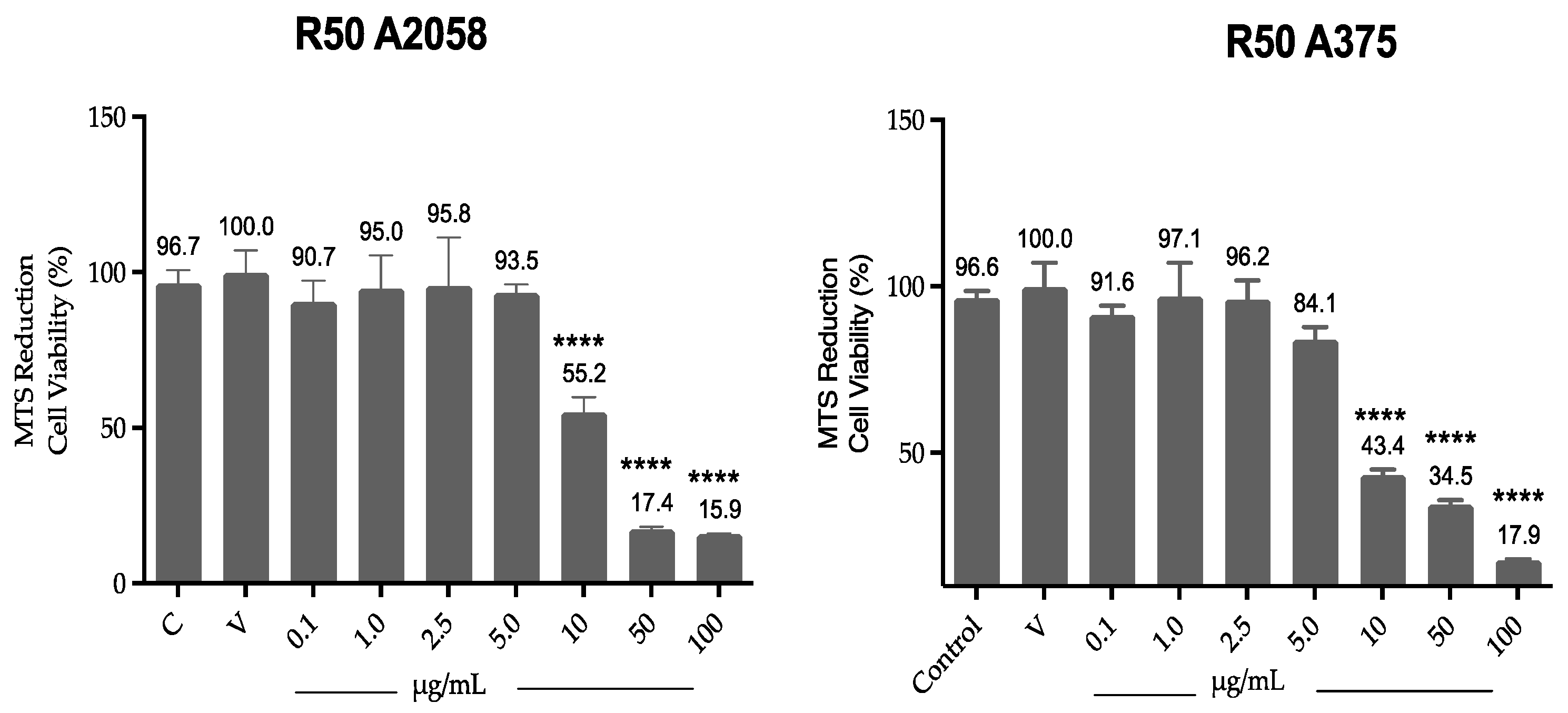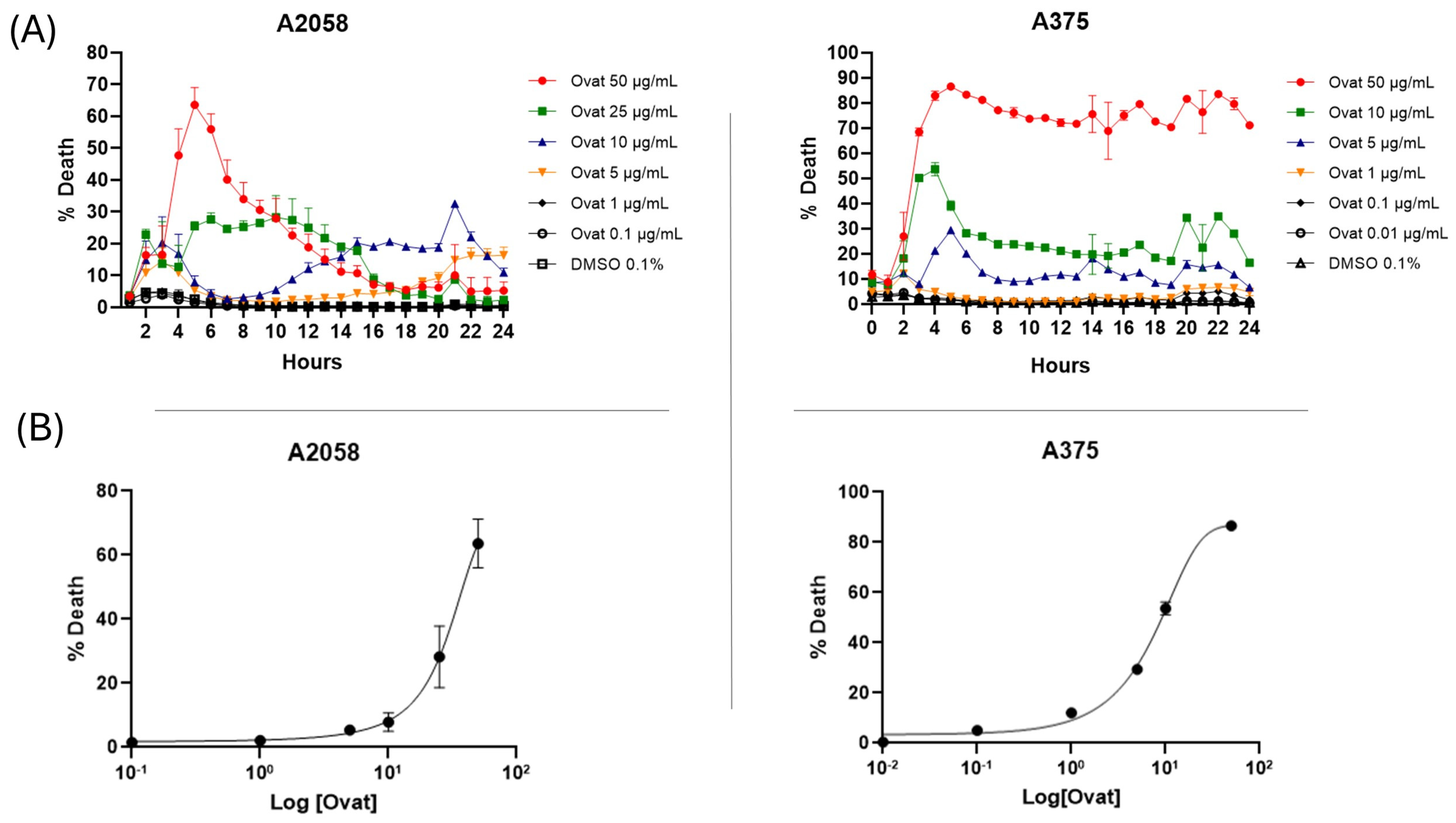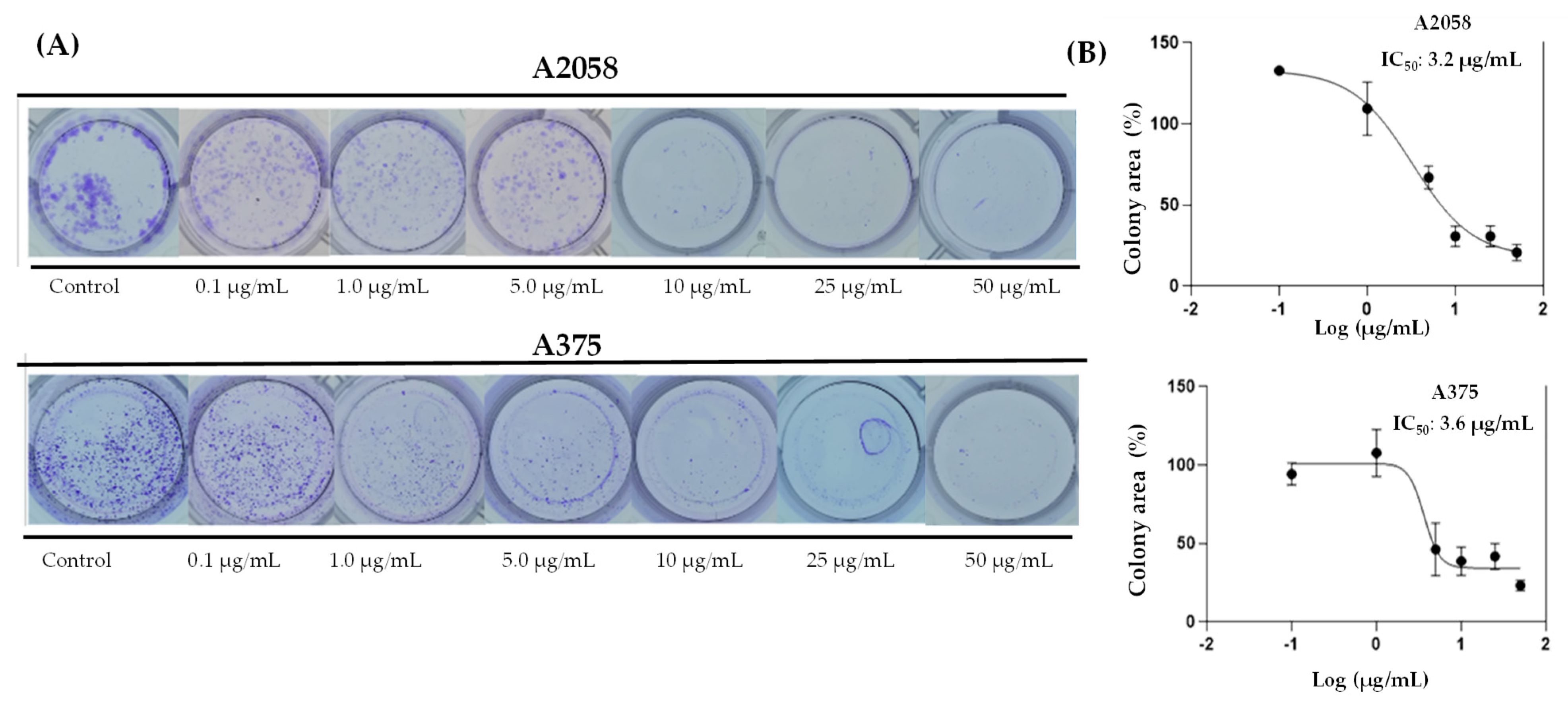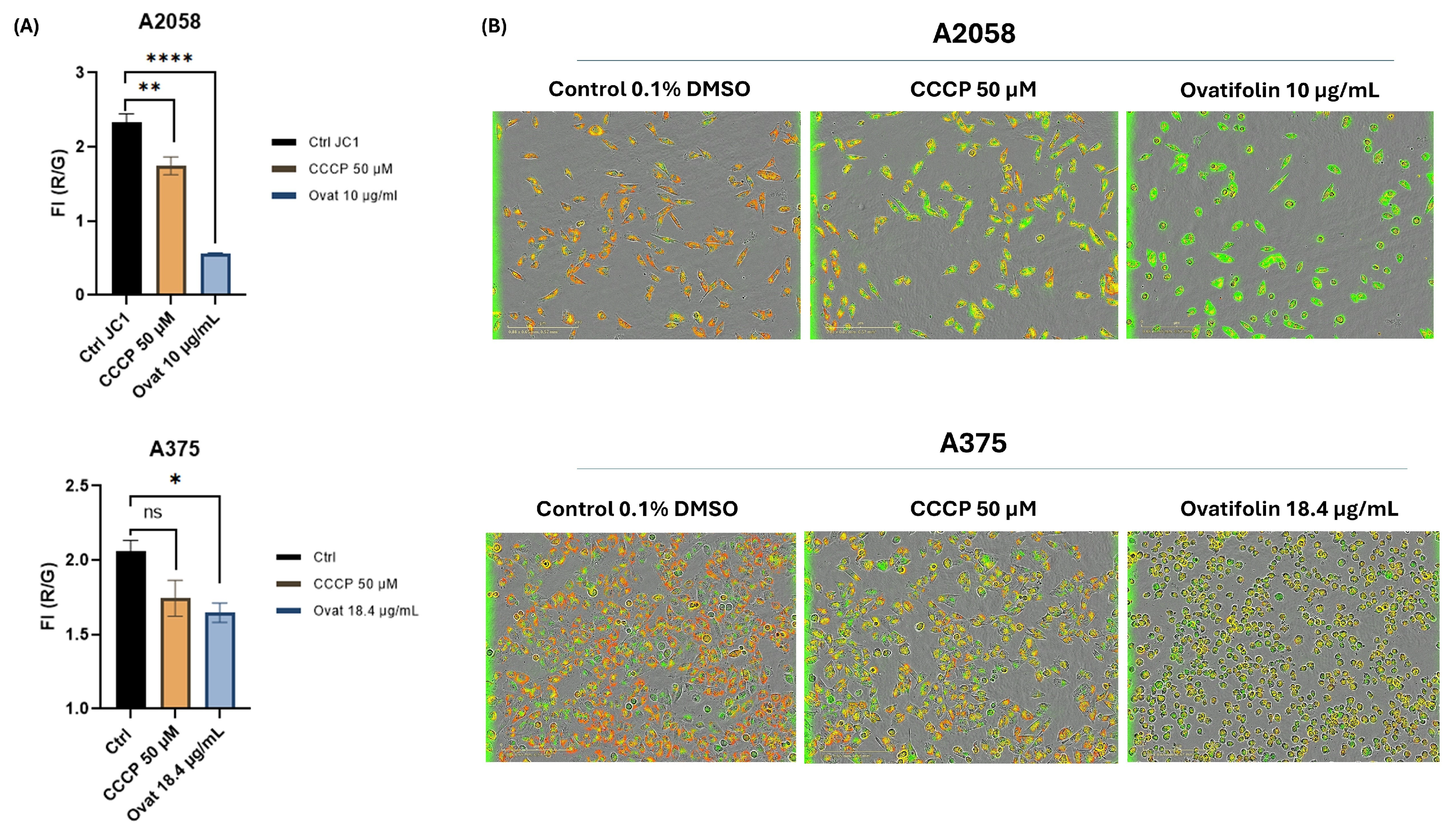Ovatifolin Isolated from Leptocarpha rivularis Induces the Death of A375 and A2958 Cells in Breast Cancer
Abstract
1. Introduction
2. Materials and Methods
2.1. Isolation and Structure Elucidation of Ovatifolin
2.2. Cell Culture
2.3. Cell Viability Analysis
2.4. IncuCyte® Real-Time Cell Death Assay
2.5. Clonogenic Assays
2.6. Cell Apoptosis Detection by Flow Cytometry
2.7. ROS Measurement
2.8. Mitochondrial Membrane Potential Analysis
3. Results
3.1. Chemical Characterization of Ovatifolin from Leptocarpha rivularis
3.2. Ovatifolin Shows Cytotoxic Effects Against A2058 and A375 Cells Lines
3.3. Ovatifolin Reduces the Proliferative Activity of A2058 and A375 Cells
3.4. Ovatifolin Exhibits Proapoptotic and Necrotic Properties in A375 Melanoma Cells
3.5. Ovatifolin Increases Cellular ROS Production and Decreases Mitochondrial Membrane Potential in Melanoma Cancer Cells
4. Discussion
5. Conclusions
Supplementary Materials
Author Contributions
Funding
Institutional Review Board Statement
Informed Consent Statement
Data Availability Statement
Acknowledgments
Conflicts of Interest
Abbreviations
| NMR | Nuclear Magnetic Resonance |
| ROS | Reactive Oxygen Species |
| IL-6 | Interleukin-6 |
| MMP2 | Matrix metallopeptidase 2 |
| COSY | Correlation Spectroscopy |
| NOESY | Nuclear Overhauser Effect Spectroscopy |
| HSQC | Heteronuclear Single Quantum correlation |
| HMBC | Heteronuclear Multiple Bond Correlation |
| ATCC | American Type Culture Collection |
| FBS | Fetal bovine serum |
| MTS | Cell Proliferation Assay |
| DMSO | Dimethyl sulfoxide |
| H2DCFDA | Dichlorodihydrofluorescein diacetate |
| CCCP | Carbonyl cyanide 3-chlorophenylhydrazone |
| CDCl3 | Deuterated chloroform |
| PI | Propidium iodide |
| IC50 | Half-maximal inhibitory concentration |
| ΔΨ m | Mitochondrial membrane potential |
References
- Nicol, N.H. Anatomy and physiology of the skin. Dermatol. Nurs./Dermatol. Nurses’ Assoc. 2005, 17, 62. [Google Scholar] [CrossRef]
- Cassidy, P. Melanoma; Springer: Cham, Switzerland, 2016; ISBN 9783319225395. [Google Scholar]
- Aggarwal, P.; Knabel, P.; Fleischer, A.B. United States Burden of Melanoma and Non-Melanoma Skin Cancer from 1990 to 2019. J. Am. Acad. Dermatol. 2021, 85, 388–395. [Google Scholar] [CrossRef]
- Saginala, K.; Barsouk, A.; Aluru, J.S.; Rawla, P.; Barsouk, A. Epidemiology of Melanoma. Med. Sci. 2021, 9, 63. [Google Scholar] [CrossRef]
- Lim, S.Y.; Menzies, A.M.; Rizos, H. Mechanisms and Strategies to Overcome Resistance to Molecularly Targeted Therapy for Melanoma. Cancer 2017, 123, 2118–2129. [Google Scholar] [CrossRef]
- Atanasov, A.G.; Zotchev, S.B.; Dirsch, V.M.; Orhan, I.E.; Banach, M.; Rollinger, J.M.; Barreca, D.; Weckwerth, W.; Bauer, R.; Bayer, E.A.; et al. Natural Products in Drug Discovery: Advances and Opportunities. Nat. Rev. Drug Discov. 2021, 20, 200–216. [Google Scholar] [CrossRef] [PubMed]
- Chaachouay, N.; Zidane, L. Plant-Derived Natural Products: A Source for Drug Discovery and Development. Drugs Drug Candidates 2024, 3, 184–207. [Google Scholar] [CrossRef]
- Avilés, J.; Uquiche, E.; Marillán, C.; Quevedo-León, R. Three-Stage Sequential Supercritical Extraction in Fixed Bed Extractor to Obtain Bioactive Compounds from Leptocarpha rivularis Leaves. J. Appl. Res. Med. Aromat. Plants 2023, 34, 100460. [Google Scholar] [CrossRef]
- Sheoran, S. Antioxidant Activity of Leptocarpha rivularis DC Flower Extract and Globularia alypum L. Authorea 2024, 1–12. [Google Scholar] [CrossRef]
- Uquiche, E.; Leal, I.; Marillán, C. Effect of Process Parameters on the Extraction Kinetics of Leptocarpha rivularis DC. in a Packed Bed Extractor Using Supercritical Carbon Dioxide. J. Supercrit. Fluids 2024, 211, 106314. [Google Scholar] [CrossRef]
- Rubio, J.; Arias, G.; Robles-Kelly, C.; Silva-Moreno, E.; Espinoza, L.; Carrasco, H.; Olea, A.F. Phytochemical Profiling and Assessment of Anticancer Activity of Leptocarpha rivularis Extracts Obtained from In Vitro Cultures. Plants 2022, 11, 546. [Google Scholar] [CrossRef] [PubMed]
- Rocha, Á.; Carlos, P.; Juan, L.-L.; Salgado-Guerrero, P. (Eds.) Communication, Smart Technologies and Innovation for Society Proceedings of CITIS 2021; Springer: Singapore, 2021; ISBN 9789811641251. [Google Scholar]
- Carrasco, N.; Garrido, M.; Montenegro, I.; Madrid, A.; Hartley, R.; González, I.; Rubilar, M.; Villena, J.; Valenzuela-Valderrama, M. Antitumoral Activity of Leptocarpha rivularis Flower Extracts against Gastric Cancer Cells. Int. J. Mol. Sci. 2023, 24, 1439. [Google Scholar] [CrossRef]
- STOE & CIE GMBH. X-Area, version 1.75; Software Package for Collecting Single-Crystal Data on STOE Area-Detector Diffractometers, for Image Processing, Scaling Reflection Intensities and for Outlier Rejection; STOE & CIE GMBH: Darmstadt, Germany, 2015. [Google Scholar]
- Sheldrick, G.M. A short history of SHELX. Acta Crystallogr. Sect. A Found. Adv. 2008, 64, 112–122. [Google Scholar] [CrossRef] [PubMed]
- Macrae, C.F.; Sovago, I.; Cottrell, S.J.; Galek, P.T.A.; McCabe, P.; Pidcock, E.; Platings, M.; Shields, G.P.; Stevens, J.S.; Towler, M.; et al. Mercury 4.0: From visualization to analysis, design and prediction. Appl. Crystallogr. 2020, 53, 226–235. [Google Scholar] [CrossRef] [PubMed]
- Wilcock, D.J.; Badrock, A.P.; Wong, C.W.; Owen, R.; Guerin, M.; Southam, A.D.; Johnston, H.; Telfer, B.A.; Fullwood, P.; Watson, J.; et al. Oxidative Stress from DGAT1 Oncoprotein Inhibition in Melanoma Suppresses Tumor Growth When ROS Defenses Are Also Breached. Cell Rep. 2022, 39, 110995. [Google Scholar] [CrossRef]
- Choudhry, P. High-Throughput Method for Automated Colony and Cell Counting by Digital Image Analysis Based on Edge Detection. PLoS ONE 2016, 11, e0148469. [Google Scholar] [CrossRef] [PubMed]
- Franken, N.A.P.; Rodermond, H.M.; Stap, J.; Haveman, J.; van Bree, C. Clonogenic Assay of Cells in Vitro. Nat. Protoc. 2006, 1, 2315–2319. [Google Scholar] [CrossRef]
- Limaa, T.C.; Souza, R.J.; Moraes, M.H.; Matos, S.S.; Almeida, F.H.O.; Steindel, M.; Biavatti, M.W. Isolation and Characterization of Sesquiterpene Lactones from Calea Uniflora Less. And Their Leishmanicidal and Trypanocidal Activities. Química Nova 2021, 44, 696–699. [Google Scholar] [CrossRef]
- Ajayi, B.E.; Oboh, B.; Minari, J.B.; Sexton, D.W.; Sarker, S.D.; Fatokun, A.A. Cola rostrata K. Schum. Constituents Induce Cytotoxicity through Reactive Oxygen Species Generationãnd Mitochondrial Membrane Depolarisation. Explor. Target. Anti-Tumor Ther. 2023, 4, 1328–1344. [Google Scholar] [CrossRef]
- Gnecco, S.; Poyser, J.P.; Silva, M.; Sammes, P.G.; Tyler, T.W. Sesquiterpene Lactones from Podanthus Ovatifolius. Phytochemistry 1973, 12, 2469–2477. [Google Scholar] [CrossRef]
- Gopalakrishna, E.M.; Watson, W.H.; Hoeneisen, M.; Silva, M. Ovatifolin, a Sesquiterpene Lactone. J. Cryst. Mol. Struct. 1977, 7, 49–57. [Google Scholar] [CrossRef]
- Hoeneisen, M.; Sicva, M.; Bohlmann, F. Sesquiterpene Lactones of Podanthus Mitiqui. Phytochemistry 1980, 19, 2765–2766. [Google Scholar] [CrossRef]
- Cespedes, C.L.; Hoeneisen, M.; Bittner, M.; Becerra, J.; Silva, M. Comparative Study of Ovatifolin Antioxidant and Growth Inhibition Activities. J. Agric. Food Chem. 2001, 49, 4243–4251. [Google Scholar] [CrossRef]
- Bohlmann, F.; Baruah, R.N.; Jakupovic, J. New Melampolides from Inula Germanica. Planta Medica 1985, 51, 261–262. [Google Scholar] [CrossRef]
- Trendafilova, A.; Ivanova, V.; Todorova, M.; Staleva, P.; Aneva, I. Terpenoids in Four Inula Species from Bulgaria. J. Serbian Chem. Soc. 2021, 86, 1229–1240. [Google Scholar] [CrossRef]
- Scott, R.; Zdero, C.; Bohlmann, F. Germacranolides, Guaianolides and Eudesmanolides from Greenmaniella Resinosa. Phytochemistry 1987, 26, 1999–2006. [Google Scholar] [CrossRef]
- Jeske, F.; Huneck, S.; Jakupovic, J. Further Sesquiterpene Lactones from Inula Salsoloides. Phytochemistry 1996, 41, 1539–1542. [Google Scholar] [CrossRef]
- Bai, L.; Liu, Q.; Cen, Y.; Huang, J.; Zhang, X.; Guo, S.; Zhang, L.; Guo, T.; Ho, C.-T.; Bai, N. A New Sesquiterpene Lactone Glucoside and Other Constituents from Inula salsoloides with Insecticidal Activities on Striped Flea Beetle (Phyllotreta striolata Fabricius). Nat. Prod. Res. 2018, 32, 552–557. [Google Scholar] [CrossRef]
- Chen, C.N.; Huang, H.H.; Wu, C.L.; Lin, C.P.C.; Hsu, J.T.A.; Hsieh, H.P.; Chuang, S.E.; Lai, G.M. Isocostunolide, a Sesquiterpene Lactone, Induces Mitochondrial Membrane Depolarization and Caspase-Dependent Apoptosis in Human Melanoma Cells. Cancer Lett. 2007, 246, 237–252. [Google Scholar] [CrossRef]
- Rozenblat, S.; Grossman, S.; Bergman, M.; Gottlieb, H.; Cohen, Y.; Dovrat, S. Induction of G2/M Arrest and Apoptosis by Sesquiterpene Lactones in Human Melanoma Cell Lines. Biochem. Pharmacol. 2008, 75, 369–382. [Google Scholar] [CrossRef]
- Jones, L.J.; Singer, V.L. Fluorescence Microplate-Based Assay for Tumor Necrosis Factor Activity Using SYTOX Green Stain. Anal. Biochem. 2001, 293, 8–15. [Google Scholar] [CrossRef]
- Cea, G.; Alarcón, M.; Weigert, G.; Sepulveda, R. Genotoxic Effects of Erioflorin Acetate and Erioflorin Methacrylate: Sesquiterpene Lactones Isolated from Podanthus Ovatifolius Lag. (Compositae). Bull. Environ. Contam. Toxicol. 1990, 44, 19–28. [Google Scholar] [CrossRef]
- Villegas, C.; González-Chavarría, I.; Burgos, V.; Cabrera-Pardo, J.R.; Schmidt, B.; Paz, C. Erioflorin and Erioflorin Acetate Induce Cell Death in Advanced Prostate Cancer Through ROS Increase and NF-ΚB Inhibition. J. Xenobiot. 2025, 15, 45. [Google Scholar] [CrossRef]
- Zhang, Y.Y.; Ren, H.; Yan, Q.L.; Li, Y.L.; Liu, Q.; Yao, G.D.; Song, S.J. SCP-7, a Germacrane-Type Sesquiterpene Lactone Derivative, Induces ROS-Mediated Apoptosis in NSCLC Cells in Vitro and in Vivo. Eur. J. Pharmacol. 2022, 925, 174989. [Google Scholar] [CrossRef] [PubMed]










| Position | 1H in δ (ppm) | m (J (Hz)) | 13C in δ (ppm) |
|---|---|---|---|
| 1 | 5.12 | dd (12.3, 4.5) | 136.5 |
| 2 | 2.42 | td (12.4, 5.3) | 25.8 |
| 2.29 | m | ||
| 3 | 2.36 | m | 39.1 |
| 2.15 | m | ||
| 4 | -- | -- | 142.2 |
| 5 | 4.84 | d (10.2) | 127.8 |
| 6 | 5.21 | dd (10.2, 8.6) | 75.0 |
| 7 | 2.75 | dt (8.5, 3.5) | 53.7 |
| 8 | 4.58 | m | 71.3 |
| 9 | 2.94 | dd (14.4, 5.4) | 42.4 |
| 10 | -- | -- | 133.2 |
| 11 | -- | -- | 138.4 |
| 12 | -- | -- | 170.3 |
| 13 | 6.34 (Z-H13) | brd (3.1) | 120.5 |
| 5.57 (E-H13) | d (3.1) | ||
| 14 | 4.77 | d (11.9) | 63.2 |
| 4.58 | d (11.9) | ||
| 15 | 1.62 | d (1.3) | 17.0 |
| –C(O)CH3 | -- | -- | 171.6 |
| –C(O)CH3 | 2.06 | s | 21.2 |
Disclaimer/Publisher’s Note: The statements, opinions and data contained in all publications are solely those of the individual author(s) and contributor(s) and not of MDPI and/or the editor(s). MDPI and/or the editor(s) disclaim responsibility for any injury to people or property resulting from any ideas, methods, instructions or products referred to in the content. |
© 2025 by the authors. Licensee MDPI, Basel, Switzerland. This article is an open access article distributed under the terms and conditions of the Creative Commons Attribution (CC BY) license (https://creativecommons.org/licenses/by/4.0/).
Share and Cite
Burgos, V.; Cortez, N.; Aguilera-Paillán, R.; Bravo-Bouchat, S.; Schmidt, B.; Sperlich, E.; Pérez, R.; Rodriguez, N.M.; Ortiz, L.; Cabrera-Pardo, J.R.; et al. Ovatifolin Isolated from Leptocarpha rivularis Induces the Death of A375 and A2958 Cells in Breast Cancer. Antioxidants 2025, 14, 1392. https://doi.org/10.3390/antiox14121392
Burgos V, Cortez N, Aguilera-Paillán R, Bravo-Bouchat S, Schmidt B, Sperlich E, Pérez R, Rodriguez NM, Ortiz L, Cabrera-Pardo JR, et al. Ovatifolin Isolated from Leptocarpha rivularis Induces the Death of A375 and A2958 Cells in Breast Cancer. Antioxidants. 2025; 14(12):1392. https://doi.org/10.3390/antiox14121392
Chicago/Turabian StyleBurgos, Viviana, Nicole Cortez, Rocío Aguilera-Paillán, Sofía Bravo-Bouchat, Bernd Schmidt, Eric Sperlich, Rebeca Pérez, Nelia M. Rodriguez, Leandro Ortiz, Jaime R. Cabrera-Pardo, and et al. 2025. "Ovatifolin Isolated from Leptocarpha rivularis Induces the Death of A375 and A2958 Cells in Breast Cancer" Antioxidants 14, no. 12: 1392. https://doi.org/10.3390/antiox14121392
APA StyleBurgos, V., Cortez, N., Aguilera-Paillán, R., Bravo-Bouchat, S., Schmidt, B., Sperlich, E., Pérez, R., Rodriguez, N. M., Ortiz, L., Cabrera-Pardo, J. R., Villegas, C., & Paz, C. (2025). Ovatifolin Isolated from Leptocarpha rivularis Induces the Death of A375 and A2958 Cells in Breast Cancer. Antioxidants, 14(12), 1392. https://doi.org/10.3390/antiox14121392







